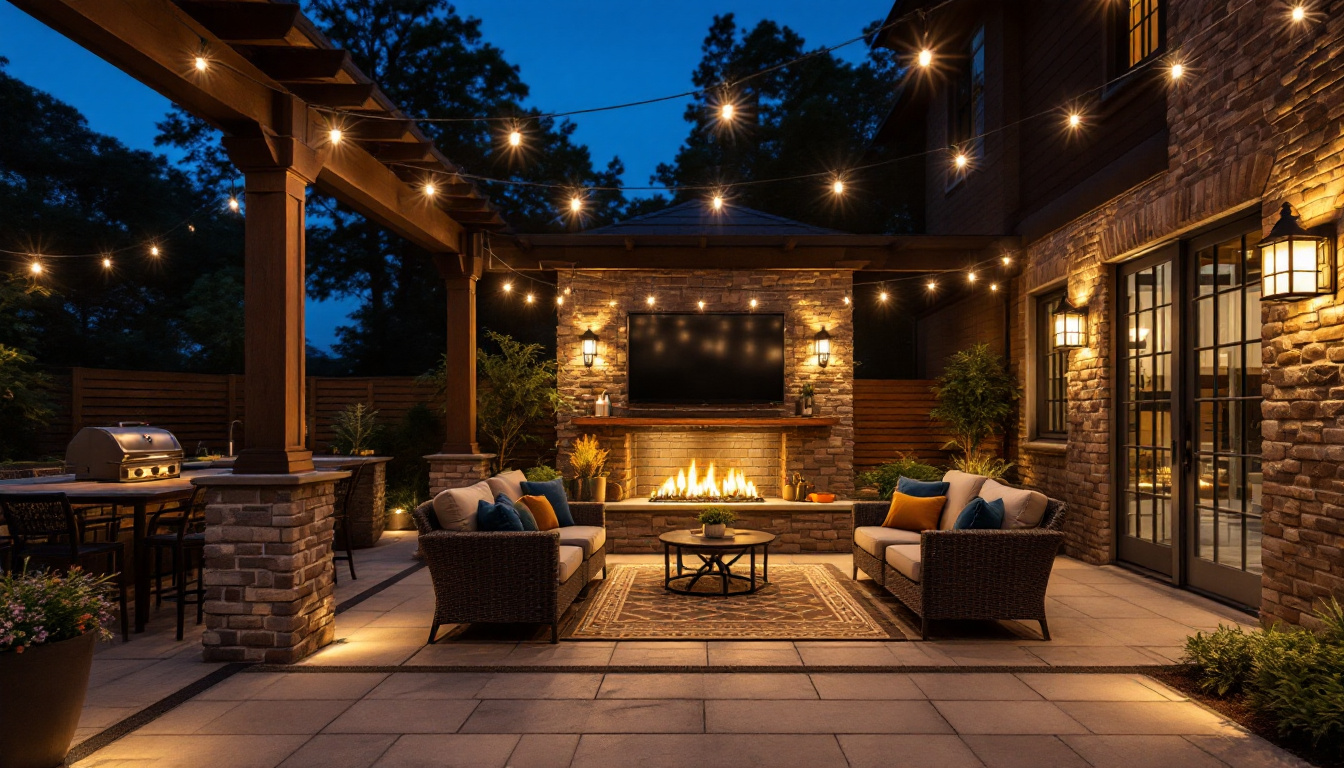
In recent years, outdoor solar lights have gained immense popularity among homeowners and contractors alike. These innovative lighting solutions harness the power of the sun, providing an eco-friendly and cost-effective alternative to traditional electrical lighting. As the demand for sustainable solutions continues to rise, understanding how to effectively implement outdoor solar lights, particularly wall-mounted options, becomes essential for lighting contractors aiming to future-proof their projects.
Outdoor solar lights not only enhance the aesthetic appeal of properties but also serve practical purposes such as improving security and visibility. With advancements in solar technology, these lights have become more efficient, reliable, and versatile, making them an attractive option for a variety of outdoor applications.
One of the most significant advantages of outdoor solar lighting is its ability to operate independently of the electrical grid. This independence not only reduces energy costs but also minimizes the need for extensive wiring and installation efforts, making it a perfect choice for remote areas or locations where traditional lighting may be challenging to implement. Additionally, many modern solar lights come equipped with motion sensors, allowing them to activate only when movement is detected, further conserving energy and extending the lifespan of the solar batteries.
Moreover, the design options for outdoor solar lights have expanded dramatically, catering to various styles and preferences. From sleek, modern fixtures to more traditional lantern designs, homeowners can find solar lighting solutions that complement their outdoor decor. Furthermore, the integration of smart technology into solar lights has opened up new possibilities, such as programmable timers and remote control features, enabling users to customize their lighting experience. As these technologies continue to evolve, the potential for outdoor solar lighting to enhance both functionality and ambiance in outdoor spaces is boundless.
Solar lights operate using photovoltaic cells, which convert sunlight into electricity. This electricity powers the LED lights installed in the fixtures. Understanding this fundamental principle is crucial for lighting contractors as it impacts the design and installation of solar-powered solutions.
When selecting solar lights, it’s important to consider the efficiency of the solar panels. Higher efficiency panels can generate more electricity from the same amount of sunlight, which is particularly beneficial in areas with limited sunlight exposure. Additionally, the capacity of the battery used in solar lights directly influences how long the lights will operate after sunset. A well-designed system takes into account not just the solar panel’s efficiency but also the geographic location and seasonal variations in sunlight, ensuring optimal performance year-round.
Moreover, advancements in solar technology have led to the development of smart solar lights that can be controlled via mobile applications. These innovations allow users to customize settings such as brightness levels and schedules, making solar lighting solutions even more versatile and user-friendly. As solar technology continues to evolve, the integration of smart features is becoming increasingly common, providing enhanced convenience and energy management for homeowners and businesses alike.
Outdoor solar wall lights typically consist of several key components: solar panels, batteries, LED lights, and sensors. Each component plays a vital role in the overall functionality of the lighting system.
The solar panel collects sunlight during the day, while the battery stores this energy for use at night. LED lights are favored for their energy efficiency and longevity, providing bright illumination without consuming excessive power. Sensors, such as motion detectors or light sensors, can enhance the functionality of solar lights by triggering illumination based on environmental conditions. For instance, motion sensors can activate the lights only when movement is detected, conserving energy and extending battery life.
In addition to these core components, some solar wall lights come equipped with additional features like adjustable solar panels that can be tilted for maximum sun exposure or built-in timers that allow users to set specific on/off schedules. These enhancements not only improve the efficiency of the lighting system but also provide greater flexibility in installation and usage. As the demand for sustainable energy solutions grows, the market for solar wall lights continues to expand, with manufacturers constantly innovating to meet the diverse needs of consumers.
One of the most significant advantages of solar wall-mounted lights is their cost-effectiveness. With no need for electrical wiring or ongoing electricity costs, these lights can significantly reduce installation and operational expenses. This makes them an attractive option for both residential and commercial projects.
Furthermore, many solar lights are designed for easy installation, allowing contractors to complete projects more efficiently. This can lead to increased profitability and the ability to take on more projects within the same timeframe.
As sustainability becomes a priority for many consumers, the environmental benefits of solar lighting cannot be overlooked. By utilizing renewable energy, solar lights contribute to reducing carbon footprints and promoting a greener planet. This aspect can be a strong selling point for contractors looking to appeal to eco-conscious clients.
In addition to reducing reliance on fossil fuels, solar lights can also help minimize light pollution. Many models are designed to direct light downward, which reduces glare and protects nocturnal wildlife, making them a responsible choice for outdoor lighting.
Before selecting solar wall lights, contractors must assess the specific requirements of each project. Factors such as the intended use of the lights, the size of the area to be illuminated, and the local climate conditions all play a crucial role in determining the most suitable lighting solution.
For example, areas with heavy tree cover may require lights with higher battery capacity to ensure they remain operational during periods of limited sunlight. Conversely, open areas with ample sunlight can benefit from standard solar lights that offer a good balance of performance and cost.
Not all solar lights are created equal. When selecting products for installation, it is essential to evaluate the quality and durability of the fixtures. Look for lights made from high-quality materials that can withstand outdoor conditions, including rain, wind, and extreme temperatures.
Additionally, consider the warranty and customer support offered by manufacturers. A robust warranty can provide peace of mind and ensure that any potential issues can be addressed promptly, safeguarding the investment made in the lighting project.
Proper installation of solar wall lights begins with a thorough site assessment. Contractors should evaluate the location for adequate sunlight exposure, ensuring that solar panels will receive direct sunlight for a significant portion of the day. This may involve trimming trees or relocating fixtures to maximize efficiency.
Once the site is assessed, preparation is key. This includes ensuring that the mounting surfaces are clean and stable. Proper anchoring of the lights is crucial to prevent them from being dislodged by wind or other environmental factors.
The placement and orientation of solar wall lights can significantly impact their performance. Ideally, solar panels should face south in the northern hemisphere to capture the most sunlight. For wall-mounted lights, positioning them at an appropriate height can enhance visibility and effectiveness.
Consider the intended use of the lighting when determining placement. For example, lights intended for security purposes should be positioned to illuminate entryways and pathways, while decorative lights may be better suited for enhancing landscaping features.
As technology continues to evolve, integrating smart features into solar lighting systems can enhance functionality and user experience. Smart solar lights can be controlled remotely via smartphone apps, allowing users to adjust brightness levels, set timers, and even monitor energy usage.
This integration not only adds convenience but also appeals to tech-savvy clients who are looking for modern solutions. Contractors should stay informed about the latest advancements in smart solar technology to offer cutting-edge options to their customers.
When designing solar lighting projects, consider scalability and flexibility. The ability to expand or modify the lighting system in the future can be a significant advantage for clients. This could involve adding more lights, integrating additional features, or even connecting to a larger smart home system.
Contractors should choose products that are compatible with various configurations and can be easily upgraded as technology advances. This foresight can lead to long-term client satisfaction and repeat business.
While solar lights are generally low-maintenance, routine care is essential to ensure optimal performance and longevity. Contractors should educate clients on the importance of keeping solar panels clean and free from debris, as dirt and grime can hinder their efficiency.
Additionally, checking the battery condition and replacing it when necessary can significantly extend the life of solar lights. Regular inspections can help identify any issues early on, preventing costly repairs or replacements in the future.
Contractors should also be aware of the lifespan of different components within solar lighting systems. LED lights can last for many years, while batteries may require replacement every few years, depending on usage and environmental conditions.
By understanding the expected lifespan of each component, contractors can better inform clients about maintenance schedules and replacement timelines, ensuring that the lighting system remains functional and effective over the long term.
Outdoor solar wall-mounted lights represent a forward-thinking solution for lighting projects, combining sustainability, cost-effectiveness, and innovative technology. By understanding the fundamentals of solar technology, evaluating project requirements, and implementing best practices for installation and maintenance, lighting contractors can successfully future-proof their projects.
As the demand for energy-efficient solutions continues to grow, staying informed about advancements in solar technology and smart features will be crucial for contractors looking to remain competitive in the market. By embracing these changes, contractors can not only enhance their offerings but also contribute to a more sustainable future.
Incorporating outdoor solar lights into lighting projects is not just about illumination; it’s about creating an environmentally responsible and innovative approach that meets the evolving needs of clients. With careful planning and execution, solar lighting can illuminate pathways, enhance security, and beautify outdoor spaces for years to come.
Ready to elevate your lighting projects with the latest in solar technology? At LumenWholesale, we offer a vast array of top-quality, spec-grade outdoor solar lights that are perfect for any wall-mount installation. Our commitment to affordability means you get the best value on wholesale lighting without the extra markups. Plus, with free shipping on bulk orders, you can stock up on the most innovative and eco-friendly lighting solutions without worrying about hidden costs. Don’t compromise on quality or cost—choose LumenWholesale for lighting that meets the highest industry standards. Wholesale Lighting at the Best Value is just a click away. Start future-proofing your lighting projects today!

Discover the must-have tools for lighting contractors when installing or troubleshooting 3-way switches.

Discover the key factors that distinguish leading lighting contractors in the industry, focusing on the crucial role of foot candles in creating optimal lighting solutions.

Discover the essentials of outdoor house lighting from a contractor’s perspective.

Discover the key insights and expectations clients have for lighting contractors in the world of LED installations.